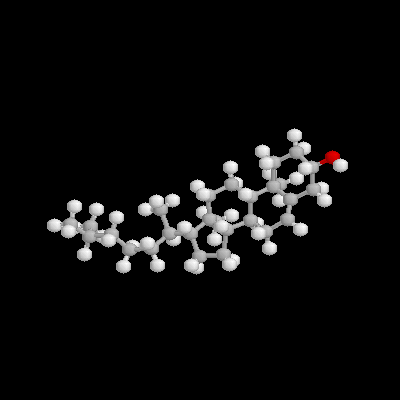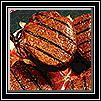 Cholesterol
is an important factor of cell membrane and the precursor of steroid hormones
and bile acids. It is an essential component to the structure of human,
yet it has been associated with cardiovascular disease and stroke. Cholesterol
are commonly associate with Low-Density Lipoprotein (LDL), and High-Density
Lipoprotein (HDL). LDL is usually known as the "bad" cholesterol
and the HDL is known as the "good" cholesterol. High blood
cholesterol (hypercholesterolemia) results from the overproduction and/or
under utilization of Low Density Lipoprotein (LDL). Two common causes of
hypercholesterolemia are
Cholesterol
is an important factor of cell membrane and the precursor of steroid hormones
and bile acids. It is an essential component to the structure of human,
yet it has been associated with cardiovascular disease and stroke. Cholesterol
are commonly associate with Low-Density Lipoprotein (LDL), and High-Density
Lipoprotein (HDL). LDL is usually known as the "bad" cholesterol
and the HDL is known as the "good" cholesterol. High blood
cholesterol (hypercholesterolemia) results from the overproduction and/or
under utilization of Low Density Lipoprotein (LDL). Two common causes of
hypercholesterolemia are
 1.
Consumption of foods that are high in saturated fat and/or cholesterol.
1.
Consumption of foods that are high in saturated fat and/or cholesterol.
2. The genetic disease Familial
Hypercholesterolemia
The levels of either types of cholesterol can be effected
by diet, exercise, alcohol, smoking, and certain illness. The LDL level
becomes higher if the diet is high in fat. In Contrast, exercising regulary
and controling the diet will increase the level of the HDL cholesterol.
Hypercholesterolemia is the disease that is directly responsible
for the top agents that kill most lives in the world: heart attack and
stroke. As a result of high consumption of cholesterol circulation in blood
vessels, over time, small deposits form plaques known as atherosclerosis
on the inside of the arteries. The deposition will eventually get large
enough to reduce and block the blood flow. Depending on where the clots
occur, certain fatal symtoms can take place. If the blockage occurs in
the arteries supplying the heart, the result is a heart attack. If the
blockage occurs in the arteries supplying the brain and causes parts of
the brain to die, the result is a stroke.
Unlike the common hypercholesterolemia, Familial Hypercholesterolemia
(FH) is a genetic disease. Patients with FH have the tendency to have much
more serious conditions than the people who have high levels of cholesterol
resulting merely from high fat diet. Patient suffers from FH has the higher
risk of heart attacks, strokes, and sudden death.
There are two main strategies for hypercholesterolemia
patient.
 1)
Ingestion of resins that bind bile acids thus prevent the intestinal absorption.
1)
Ingestion of resins that bind bile acids thus prevent the intestinal absorption.
2) Treatment with cholesterol-lowering
drugs.
Unfortunately, the decreased serum
cholesterol level, resulting from the ingestion of resins that bind bile
acids, also induces the synthesis of HMG CoA reductase, which increases
the cholesterol biosynthesis. More effective ways of treatment are the
cholesterol-lowering drugs which inhibits the HMG CoA reductase thus reducing
the rate of cholesterol synthesis. There are many cholesterol-lowering
drugs in the market. The main target of the drugs is to lower the serum
cholesterol and LDL levels. An example of these drugs is lovastatin.
 Abstract
Abstract
 Cholesterol
Cholesterol
 Familial
Hypercholesterolemia
Familial
Hypercholesterolemia
 Lovastatin
Lovastatin
 Any
comments or suggestions?? thamrong@panther.middlebury.edu
Any
comments or suggestions?? thamrong@panther.middlebury.edu
 Cholesterol
is an important factor of cell membrane and the precursor of steroid hormones
and bile acids. It is an essential component to the structure of human,
yet it has been associated with cardiovascular disease and stroke. Cholesterol
are commonly associate with Low-Density Lipoprotein (LDL), and High-Density
Lipoprotein (HDL). LDL is usually known as the "bad" cholesterol
and the HDL is known as the "good" cholesterol. High blood
cholesterol (hypercholesterolemia) results from the overproduction and/or
under utilization of Low Density Lipoprotein (LDL). Two common causes of
hypercholesterolemia are
Cholesterol
is an important factor of cell membrane and the precursor of steroid hormones
and bile acids. It is an essential component to the structure of human,
yet it has been associated with cardiovascular disease and stroke. Cholesterol
are commonly associate with Low-Density Lipoprotein (LDL), and High-Density
Lipoprotein (HDL). LDL is usually known as the "bad" cholesterol
and the HDL is known as the "good" cholesterol. High blood
cholesterol (hypercholesterolemia) results from the overproduction and/or
under utilization of Low Density Lipoprotein (LDL). Two common causes of
hypercholesterolemia are 1)
Ingestion of resins that bind bile acids thus prevent the intestinal absorption.
1)
Ingestion of resins that bind bile acids thus prevent the intestinal absorption.